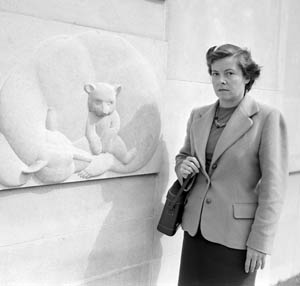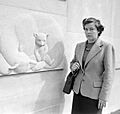Elizabeth Bradford Holbrook facts for kids
Quick facts for kids
Elizabeth Bradford Holbrook
|
|
|---|---|
 |
|
| Born |
Elizabeth Mary Bradford
November 7, 1913 Hamilton, Ontario, Canada
|
| Died | February 23, 2009 (aged 95) Hamilton, Ontario, Canada.
|
| Nationality | Canadian |
| Education | Ontario College of Art |
| Known for | Sculptor and designer |
|
Notable work
|
Federal Building "Wildlife and Industry" panels ca. 1952, "George Bernard Shaw" 1997, "Emanuel Hahn" 1952, "Family Tree" 1960. |
| Awards | Lieut. Governor’s Silver Medal for Sculpture, 1935; National Sculpture Society of New York, Gold Medal, 1969 and the Canadian Portrait Academy Cleeve Horne Award - Best Portrait Sculpture, 1998 |
Elizabeth Bradford Holbrook (November 7, 1913 – February 23, 2009) was a famous Canadian artist. She was a sculptor, which means she made art by shaping materials like clay or metal. She was especially known for her portrait sculptures, which are sculptures of people. Elizabeth also designed medals and created art for churches. She was honored with the CM and the O.Ont, which are high awards in Canada.
Contents
Becoming a Sculptor: Elizabeth's Education
Elizabeth Bradford Holbrook was born in Hamilton, Ontario, on November 7, 1913. She came from a family with a long history in Canada. Her great-great-grandfather, John Willson, was an important speaker in the government of Upper Canada a long time ago.
Elizabeth loved art from a young age. She studied at several art schools to learn her craft. These included the Hamilton Art School (from 1928 to 1931) and the Ontario College of Art (from 1932 to 1935). She also traveled to England to study at the Royal College of Art in London in 1936. Later, in 1948, she studied at the Cranbrook Academy of Art in Michigan, USA.
During her studies, Elizabeth learned from many talented artists. Some of her teachers were Hortense Gordon, John S. Gordon, John Sloan, Gustav Hahn, Emanuel Hahn, Rowley Murphy, and Carl Milles. These teachers helped her become the amazing sculptor she was.
Elizabeth also shared her knowledge with others. She taught sculpture at the Dundas Valley School of Art from 1965 to 1969. She also taught at the Burlington Cultural Centre and McMaster University in Hamilton. Her portrait sculptures are so well-known that you can find them in over 50 public collections around the world!
Famous People and Important Works
Elizabeth Holbrook created sculptures of many important people. She sculpted Queen Elizabeth II, who was the Queen of the United Kingdom and other Commonwealth countries. She also sculpted William Osler, a famous doctor, and Ellen Fairclough, Canada's first female cabinet minister. Other important figures she sculpted include John Diefenbaker, a former Prime Minister of Canada, and fellow sculptors Emanuel Hahn and Henry Moore.
One of her notable works is a large bronze statue of a Royal Military College of Canada cadet. This 24-foot-tall standing figure was made in 1979. It became known as ‘Brucie’ and was a gift from the Royal Military College Club.
She also made a bronze bust (a sculpture of a person's head and shoulders) of Colonel George Stanley. Colonel Stanley was a professor at the Royal Military College. He is famous for designing the Canadian Flag, which is the red and white flag with the maple leaf.
For the Federal Building in Hamilton, Ontario, Elizabeth created eight large stone panels. These panels show scenes of wildlife and industry. They are a type of sculpture called "mezzo relief," where the figures stick out slightly from the flat background.
In 1996, she completed a sculpture of George Bernard Shaw. He was a famous writer from Ireland. This sculpture is in a plaza in Niagara-on-the-Lake, Ontario. Her last sculptures were of Conrad Black and his wife Barbara Amiel, which she made in 2000 and 2002.
Elizabeth's Legacy
Elizabeth Holbrook passed away peacefully in Hamilton on February 23, 2009. She is buried at St. John's Anglican Church in Ancaster, Ontario. She rests beside her husband, "Jack" Holbrook, and her son, William "Billy" Holbrook. The headstone for her family's grave was designed by Elizabeth herself.
Elizabeth also helped and taught other artists. She mentored and influenced Canadian sculptor Christian Cardell Corbet, who continued her artistic legacy.
Memberships
Elizabeth Holbrook was a member of many important art groups and received special honors:
- Order of Canada
- Royal Canadian Academy of Arts
- Ontario Society of Artists
- Sculptors' Society of Canada
- Canadian Portrait Academy, 1997 - Founding Member
- Order of Ontario
- International Art Medal Association (FIDEM)
- Medallic Art Society of Canada
- Canadian Group of Art Medallists
Awards and Honours
Elizabeth Holbrook received many awards for her amazing work:
- 1935: Awarded the Lieutenant Governor's Medal for Painting at the Ontario College of Art.
- 1969: Won the Gold Medal for Portraiture from the National Sculpture Society of New York.
- 1977: Received the Queen Elizabeth II Silver Jubilee Medal.
- 1987: Named "Woman of the Year in the Arts" by the City of Hamilton, Ontario.
- 1994: Became a Member of the Hamilton Hall of Distinction.
- 1982: Awarded the Ontario Society of Arts Award.
- 1992: Received the 125th Anniversary of the Confederation of Canada Medal.
- 1996: Appointed as a Fellow of the Ontario College of Art & Design.
- 1997: Appointed to the Order of Ontario.
- 1997: Appointed as an Officer of the Order of Canada.
- 1997: Awarded an Honorary Doctorate by McMaster University.
Images for kids


